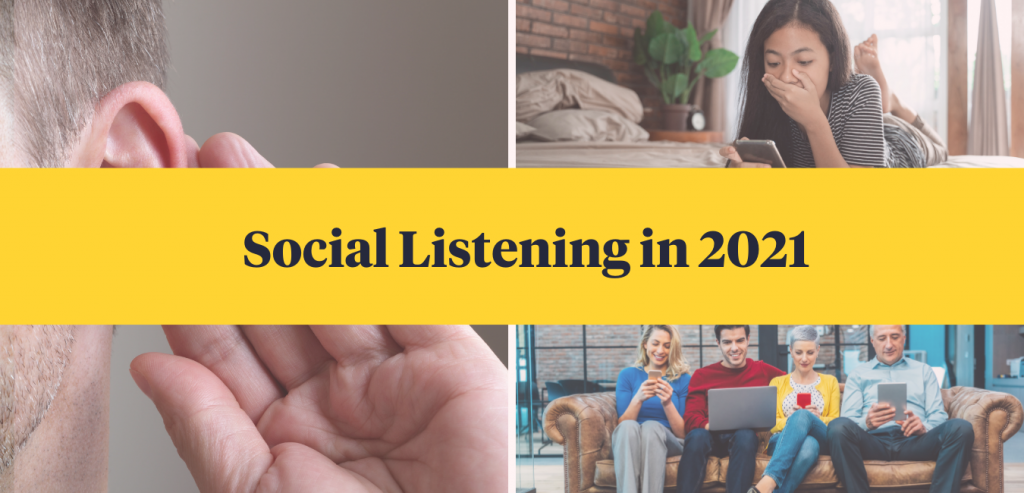
A sound social media listening practice is essential to every brand or business. It can help with reputation management, brand health, customer service, SEO, and market research.
Most importantly, it helps brands truly understand and connect with their audiences and customers. We’d go as far as saying that a good social listening practice is the key ingredient in having happy customers and an engaged audience.
Ever wonder how do you develop a winning product or service? By giving your customers what they want or need, of course.
And how can you find out what your audience wants and needs? Two words: Social listening.
- What Is Social Listening?
- Social Listening vs Social Monitoring
- Importance of Social Listening
- Who Can Use Social Listening?
- 5 Steps to Create a Social Listening Strategy
- How to Set Up Social Listening for Your Brand?
- Social Listening Tools
- Final Thoughts (Your audience is talking, are you listening?)
What Is Social Listening?
Social media listening consists in identifying and analyzing social media activity around topic(s) of interest.
For marketers, social listening is the process of monitoring online conversations and turning them into powerful insights that drive your business strategy. The key word here is “insights”, which are attained from online conversations.
For instance, every modern business, regardless of its size, needs to know what existing and ideal customers say about:
- their brand
- their product or service
- their campaigns
- specific keywords and topics
- their competition
Social Listening vs. Social Monitoring


Social Media Listening focuses on those conversations outside of your control (user-generated, competitors’, industry leaders and product-related content.) On the other hand, social media monitoring focuses on tracking and analyzing how audiences respond to your content.
Unlike social media monitoring, social listening helps brands understand not only what your audience talks about online, but also the “why” behind all those conversations.
Here are some differences between the two:
- Social media monitoring is a daily activity that focuses on individual social media mentions, while social listening is a strategic process that focuses on identifying patterns and trends.
- Social media monitoring is the process of tracking and collecting the data – and social listening is the process of analyzing the data and extracting the meaning from it.
- Social media monitoring is reactive – it’s about monitoring conversations and reacting to comments, complaints, or praise in a timely manner. Social listening on the other hand is proactive. Its end goal is to provide businesses with audience insights that can help companies develop a more informed strategy.
In other words, social media monitoring is the first step in the social listening process. The figures and statistics gathered through monitoring of online channels help in noticing patterns and identifying gaps in your content.
However, social listening goes a step further and turns the raw data into insights that you can use to spot opportunities to develop and grow your business. It can help consolidate your position into existing markets, expand into new verticals, or improve customer care and grow your brand loyalty.
Importance of Social Listening
To succeed in the modern business landscape, companies have to adopt a customer-centric strategy. Being customer centric (or customer driven) simply means getting closer to your customer in order to understand what they need and expect from your brand.
Knowing and delivering exactly what your customer wants is the best possible user experience.

Social listening helps you understand what gets your customers out of bed in the morning and what keeps them up at night.
It gives you insight into their expectations, the challenges they face every day, and their biggest pain points. It shows you what you do right, as well as if there are some areas where you could improve.
It also gives you a clear understanding of your competitors: why customers buy from them, what they don’t do so well, and what are some gaps you can exploit.
Next, we’ll go through some of the benefits of an effective social listening strategy. This will give you a better understanding of how you can operationalize social listening within your organization.
Benefit 1: Use Social listening to develop an informed roadmap
Great products solve real customer problems. And social listening can give you detailed insights on what those problems are.
Start by asking yourself: What do you customers expect and need from your product or service? What are some features that could make their experience better?
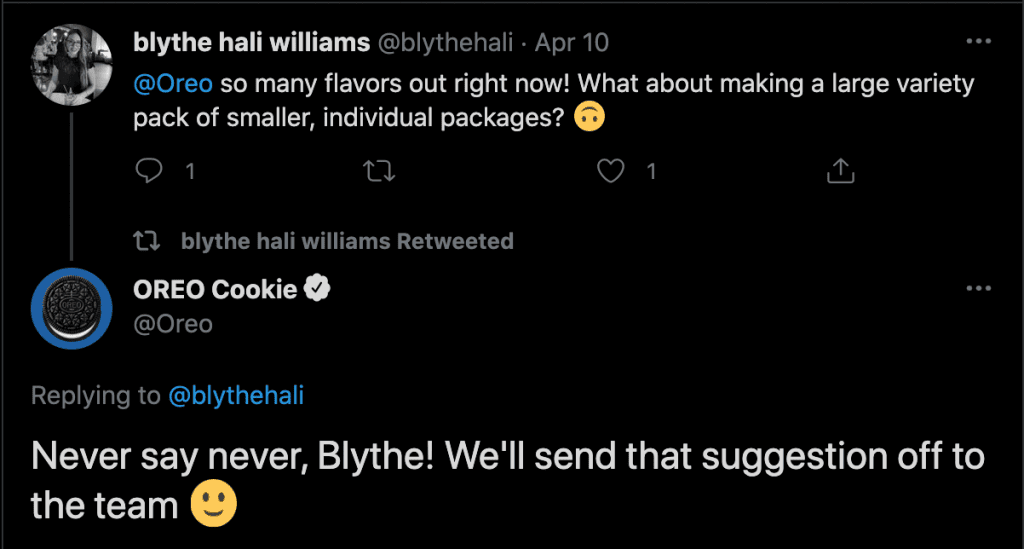
For example, if you notice customers praising your customer support and care online – you can use industry-leading support as one of the differentiators that separates you from your competitors.
However, you might also notice that people mention that there is a high learning curve and they need additional support during setup.
You can use this information to organize additional group training sessions around specific features or workflows. In the long term, you can create a more intuitive onboarding experience within your product with in-app guidance, online help centre and so on.
Then, you might use this feedback and introduce new integrations or add features that are currently missing.
Benefit 2: Use Social Listening to gather competitor intel
Great brands keep tab on their competitors.
The more you know about your competitors’ positioning, reputation, upcoming launches and so on, the easier it will be to differentiate your brand, exploit gaps and adopt best practices.
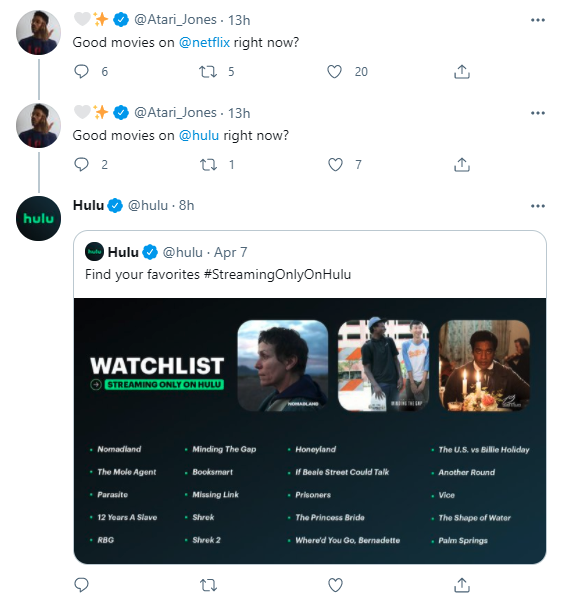
Social listening helps you keep tabs on your competitors and stay in the know about the features they’re developing, their brand sentiment, online reputation, things that are working well for your audience, as well as new channels and formats they’re exploring.
Benefit 3: Social listening to understand your consumer better
Your ideal customers share their challenges, ask for advice, and help each other online. Monitor online conversations to learn what are the pain points of your audience.
Then use this knowledge to develop solutions to these problems, or craft marketing messaging that resonates and inspires action.
Benefit 4: Social listening to find inspiration for new content
We already mentioned you can use your ideal customers’ own words to describe their needs and your solution.
Social listening also helps you track trending topics and conversations that can serve as inspiration for your next evergreen and topical content pieces.
Benefit 5: Social listening to manage crisis and maintain your reputation
Being online and being seen comes with many risks – including bad reviews, unsatisfied clients, or even unfair competition against your business.
Social listening helps you identify potential crisis events and handle them before they escalate and hurt your business.

Benefit 6: Social listening to find influencers and brand ambassadors
Social listening can help you surface influential individuals among people engaging in conversations around topics and keywords related to your niche. In fact, these influencers may already use your product, or they could be opinion leaders who are well-known and respected in your industry.
Also, social listening can surface when influencers or celebrities are mentioning your product or following your accounts. Even if there isn’t a potential partnership in sight, you can still benefit from this unintentional endorsement.
Either way, social listening makes it easy to find right-fit influencers for different campaigns or successfully launch a brand ambassador program.
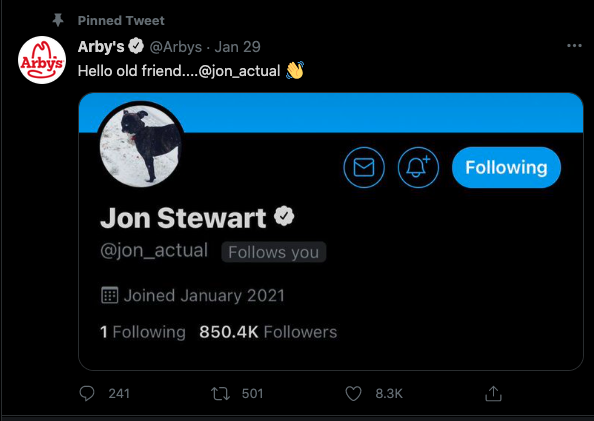
Benefit 7: Social listening for lead generation
Did you know that there is someone at this moment who is already looking for a product like yours?
Social listening will help you find customers at the consideration and purchase stages.
Many are already on social media asking their peers for recommendations and using social listening can help you sell or engage in an informed manner.
Benefit 8: Social listening to improve SEO
We already mentioned how social listening can help you determine exactly which keywords your audience is using to find your products, which should inform your content strategy. Using your audience’s own language and terms can have a huge impact on your SEO.
Also, social listening can help you find link-less mentions as well mention opportunities to build links to your website, which will impact your SEO.
Keeping an eye on the most influential voices in your industry or niche can also surface opportunities for guest-posting, and co-marketing opportunities which will increase your website traffic.
Who Can Use Social Listening?
Brands can use social listening to improve the overall business strategy, set better KPIs for different departments, and solidify their positioning. But can ALL brands benefit from social listening?
Let’s see how various types of businesses operating in different markets can adopt social listening and use it to their advantage.
1. D2C Brands
One of the most important advantages that D2C brands have over brands with a different model is their unlimited access to the voice-of-customer and consumer insights.
Social listening helps D2C brands improve their products by giving them uninterrupted insights into customer satisfaction, sentiment and reviews. It also helps them understand their customer journey and eliminate frictions.
By monitoring direct and indirect mentions on social media platforms like Twitter and Instagram, you’ll be able to collect real-time audience insights. Social media listening tools like Keyhole allow you to see relevant Twitter and Instagram posts from a single dashboard.
Mentions along with hashtag tracking should be performed regularly to ensure requests are dealt with in a timely manner and maximize the value from positive mentions. By using a social listening tool, D2C brands are able to derive smart insights from data taking into the context of conversations as well as the geographic, demographic and topic indicators.
Then, they can use these insights to develop better products, and remove friction from their buyer experience. Also social listening can help build trust and positive brand sentiment by initiating personalized conversations with consumers.
Warby Parker is one of the leading D2C brands to learn from. On Twitter, you’ll see that they’re constantly listening to conversations… and talk back.
They’re also known for using User Generated Content frequently in their campaigns.
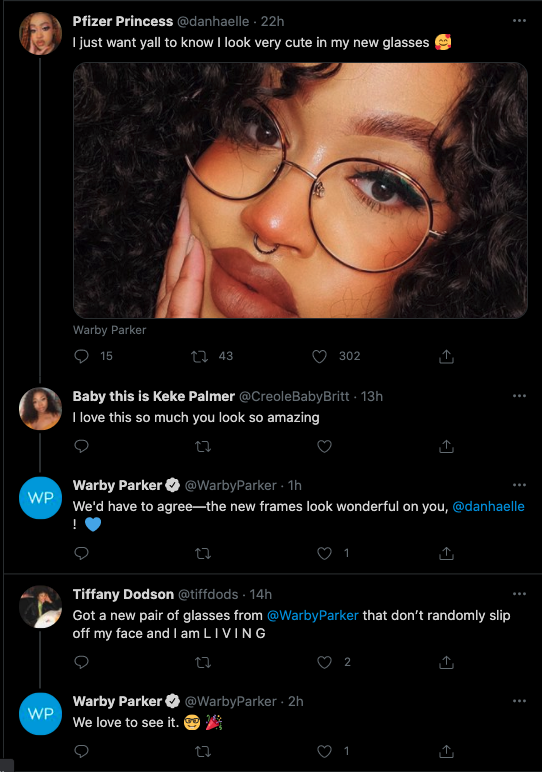
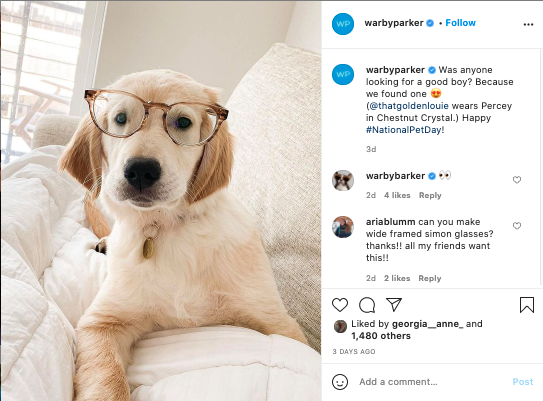
2. OTT Platforms
How can over-the-top media platforms like Netflix benefit from social listening?
Social listening gives OTT platforms insight into public sentiment and popularity of shows. Then they can use these insights in different ways.
First, by tracking the most popular shows and characters, OTT platforms can create highly relevant, engaging content on their social media channels.

Social listening also can help OTT platforms spot opportunities and pick up shows that competitors have decided to cancel.
Back in 2018, Fox cancelled two of its shows: Lucifer and Brooklyn Nine Nine. Passionate fans of the shows weren’t happy – and they weren’t going to let the shows get canceled.
Soon, the fan-launched campaigns #SaveLucifer and #RenewB99 went viral. Even celebrities with huge followings, like Hamilton creator Lin-Manuel Miranda, took to their social platforms to show their discontentment,
With millions of viewers showing their support for Fox’s cancelled shows, it was only logical that other interested buyers would appear. It wasn’t long before the shows were picked up by Netflix and NBC respectively.
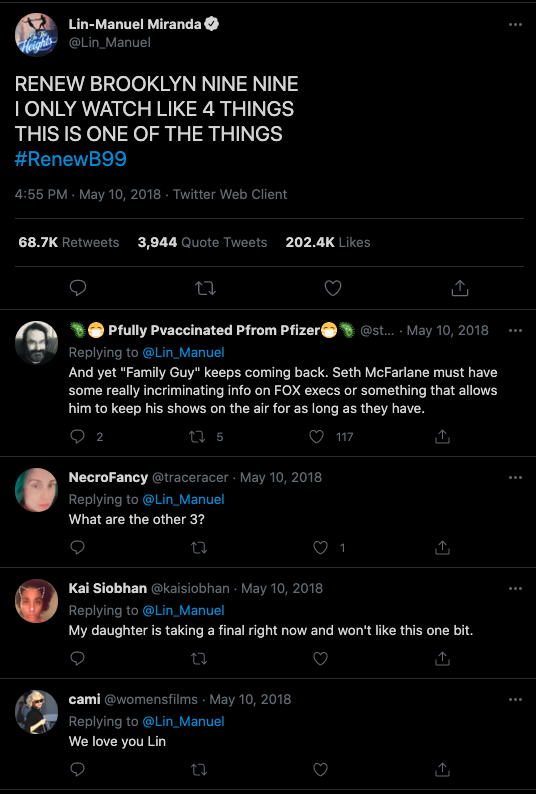
Another great example of social listening done right are the Netflix socks. Netflix has always been a customer-centric brand that understands the habits of their viewers.
By listening to online conversations, Netflix learned that many people binge watch themselves to sleep (only to wake up wondering what they missed and what happened).
This realization gave birth to the Netflix socks idea; smart socks that can detect when you’ve fallen asleep. And when that happens, they pause the show you’re watching automatically.
3. Government Organizations
The internet has changed the way brands communicate with consumers. Similarly, it has reshaped the way governments communicate with their citizens.
Now, the public can easily engage in conversations with government organizations and state their opinion about important political issues.
This shouldn’t be surprising. After all, politics is one of the most widely discussed topics on the internet.
People react to everything government bodies do. And many governmental institutions already monitor online conversations.
Social listening allows government bodies to get an instant view on opinion and sentiment. In turn, these governments are able to understand the impact of their strategies and policies, as well as react accordingly when and where needed.
4. B2B Companies
Social listening can also be very valuable to B2B brands. That is because B2B companies usually have longer sales cycles and more expensive products, they need to make sure they reduce customer churn and get more repeat business.
B2B companies can social listen to understand customer problems, workflows, how they manage their product roadmaps and needs to create better products and sales processes. It can also help them understand common questions and sentiment, so they can improve customer care and support.
Responding to negative mentions and unsatisfied customers is crucial when it comes to maintaining a good reputation. Positive mentions are important as well, as they show the teams what they do right.
Savvy B2B marketers collect and analyze social media mentions to understand voice-of-customer and inform their product messaging. They can, also, create campaigns that show ROI, satisfaction, quality of support, likelihood to recommend and so on.
Additionally, since B2B brands frequently come head-to-head with competitors, staying on top of competitor mentions is crucial.
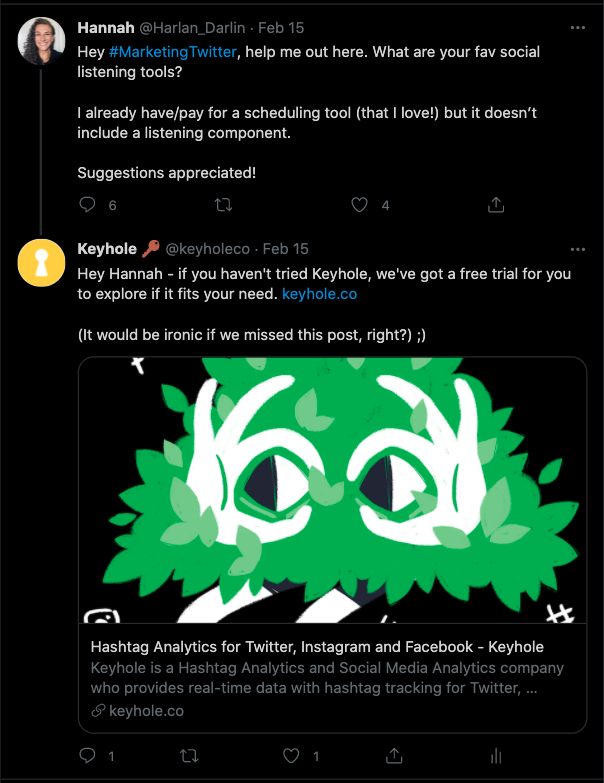
Social listening can help B2B companies:
- Identify weak spots and gaps they can exploit
- Understand where most of their competitors’ users are based, and which markets they go after
- Learn more about the features they are developing
- Decode competitors’ launches. Including, what works and what doesn’t fly with their audience.
- Identify the channels and content formats competitors are using
- Identify influencers that their competitors work with
- Find out if certain competitors are badmouthing their brand or actively campaigning against them
- Identify users who aren’t satisfied with their competitor’s product or service and reach out to them immediately
… and so much more.
Then, B2B brands can use this data to:
- Benchmark their performance against their direct competitors
- Create competitor battlecards and comparison one pagers
- Manage crisis and respond to negative comments in a timely manner
- Make changes to their roadmap so they stay ahead of the competition
- Explore new channels and formats, and avoid working with influencers who are already working with their competitors
- Engage with users who aren’t satisfied with competitors so they can try to “steal” them from the competition and convert them into their own customers
Having a social listening tool would allow this competitive analysis process and benchmarking to be seamless and automated. This, would not only save marketers hours of research and reporting every month, but also enable them to track their competitors’ performance in real time.
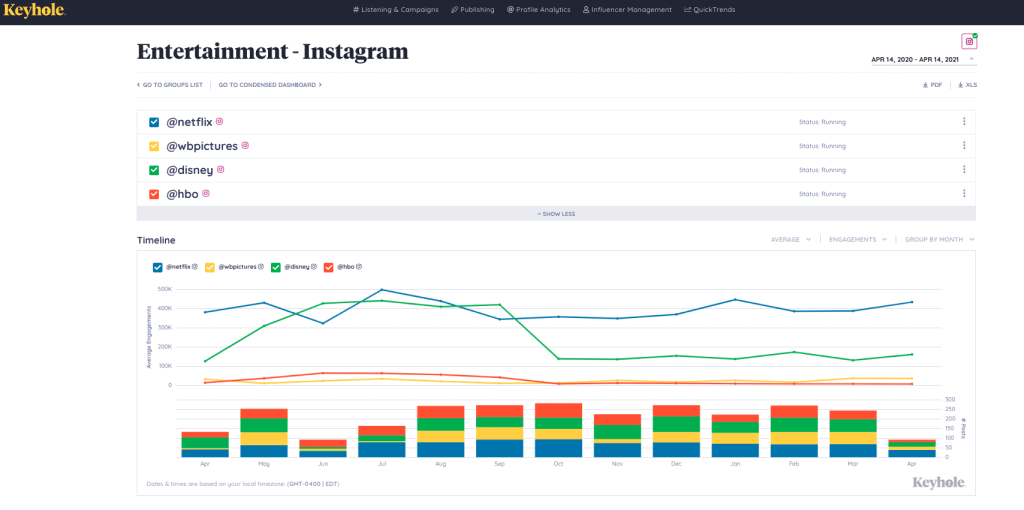
5 Steps to Create A Social Listening Strategy
By now, it’s clear that the question isn’t whether you should use social listening to power up your business, but how you can create a social listening strategy that delivers value across all departments in your organization.
Here are 5 steps to kick off a successful social listening strategy and prove value fast:
Step 1. Decide who owns social listening and what goals it will support
The first step is deciding who will be in charge of building and scaling your social listening strategy.
Making sure there’s someone that owns this as a project is crucial, as it will ensure you dedicate time and resources to social listening within your organization.
Once you allocate the responsibilities and know who will own your social listening strategy – you need to decide what goals you’d like social listening to support.
As we already mentioned, a robust social media listening strategy can help you achieve multiple benefits. Depending on who owns the project, you may decide to support different departments and goals. Some of these can include:
- Product development
- Product marketing and sales
- Demand generation
- Customer success or customer service
- HR
- PR
If you’re just getting started with social listening, it would be wise to pick only noe or two main goals and stakeholders across the organization. Once you’ve proven value and learned what works for your teams, you can scale your social listening strategy.
Step 2: Set up your social listening tool
- Social platforms you want to track
- Social listening goals and metrics to track them
- Automated solutions: tracking, reporting, alerts, etc.
- ROI
Step 3: Pick your topics and top priority platforms
Next, you need to to pick the right keywords, as well as the social media platforms you’ll monitor. To do this you need to know your audience and the platforms they use. Be as specific as possible when picking your topic to get highly relevant insights.
It’s worth noting that you probably won’t pick the best topics right off the bat. Just like with any other new initiative, you need to get started, gather some initial data, review performance, and refine your topics as the data comes in.
And even the topics you initially pick give you great results, make sure you keep refining your strategy and testing different keywords and topics to find the most relevant conversations for your brand.
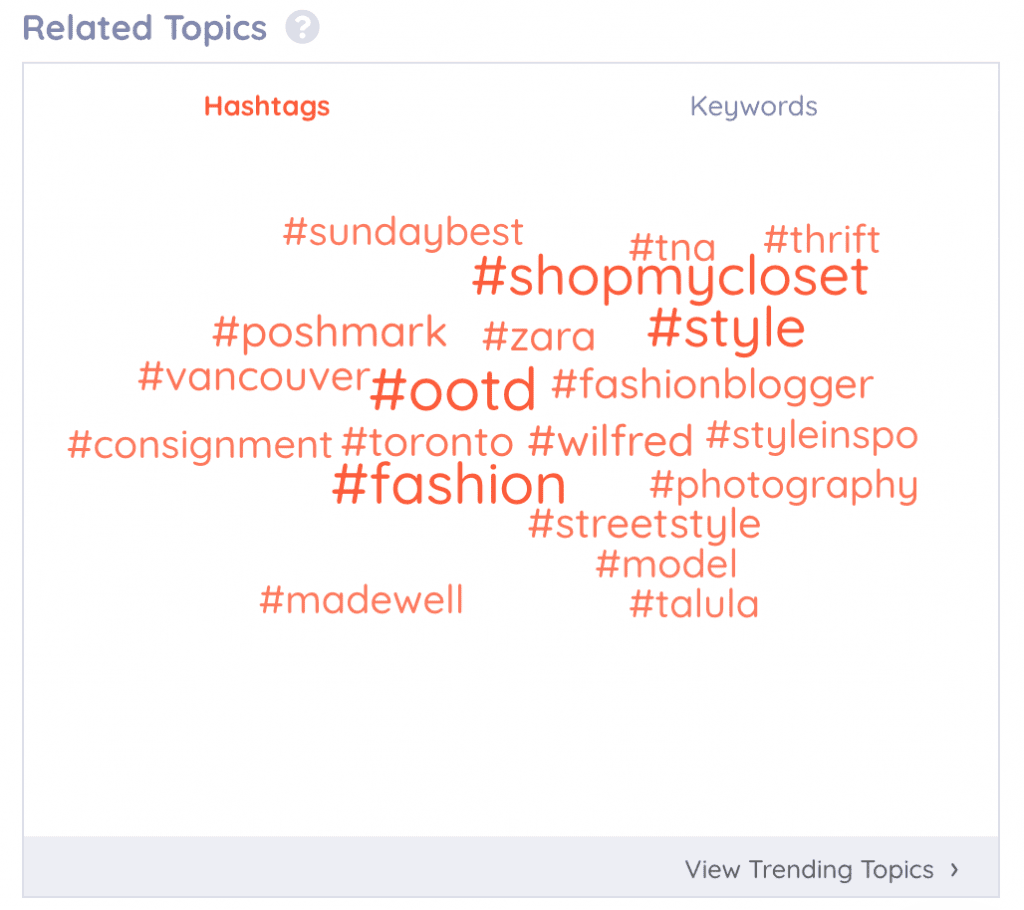
Step 4: Establish your analytics process
At this point, you’ve laid the groundwork: you know what tool you’ll use, what topics you’ll track, what goals you’ll support, and you’ve established ownership.
Next, you need to establish your analytics and social reporting process.
Decide what you’ll report, how frequently and who needs to be kept in the loop. This will depend on the goals you’ve decided to support with social listening.
Then, make a decision about what will be the primary means of communication: you may decide to send weekly reports to key stakeholders, set up monthly meetings for review of insights, or include social listening insights in departmental meetings.
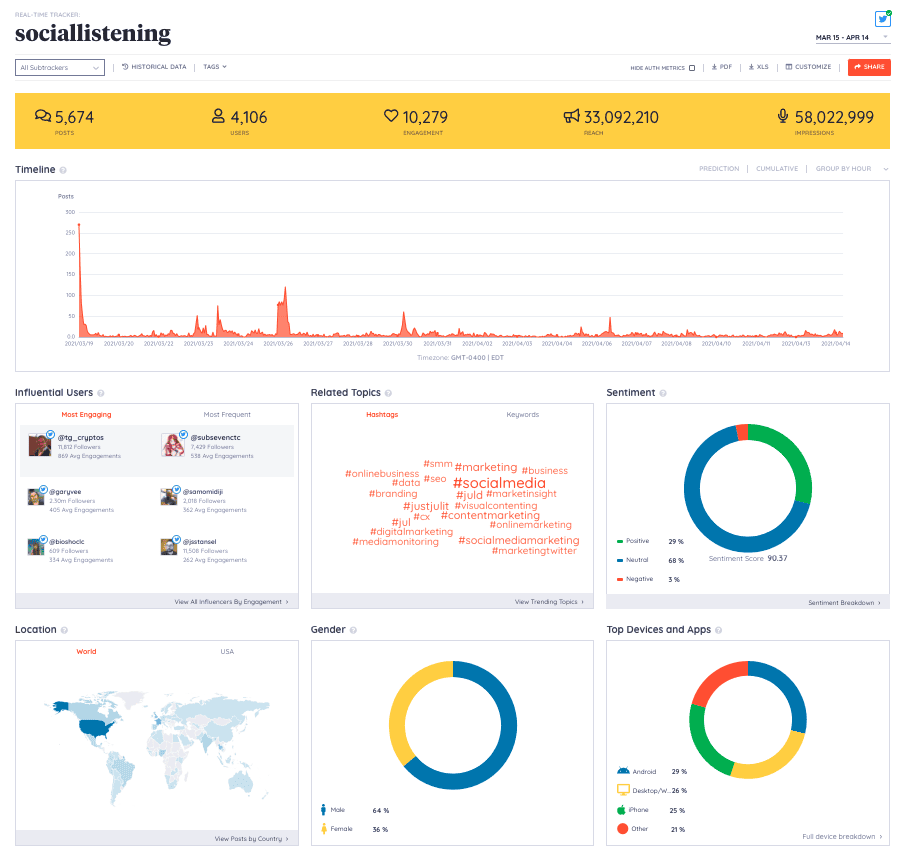
Step 5: Get started
If you followed the first four steps, you’ll have a fully working social listening function that’s linked to specific goals and stakeholders.
As mentioned, your initial framework won’t be your final framework.
Over time, you’ll notice areas of inefficiency and will improve your strategy. You’ll get additional people involved, expand the topics you monitor, and create an efficient process to derive insights and plan next steps.
But to be able to improve, first you need to get started.
How to Start Set Up Social Listening for Your Brand
Now you know how you can use insights derived from social listening to inform your strategy and enable better business outcomes. It’s time to set up social listening for your brand.
Getting your social listening activity started with Keyhole is easy.
Step 1: Set up your trackers
You can set up trackers for mentions, hashtags as well as keywords (both exact match and broad match).
The boolean search helps you define exactly what you want to listen to – as well as what topics you’d like to exclude.
This video will show you how easy it is to get your trackers set up.
Step 2: Add sub-trackers for better segmentation and insights
Sub-trackers will help you group the data you collect.
Also, using sub-trackers will help you segment the data you collect when listening to your main tracker. In turn, this will make reporting a lot easier easier.
Here is how you do it.
Step 3: Set up your filters
Not all conversations are important – that’s why you need to set up your filters, so you can track posts that come from relevant sources, geographies and languages.
Filters can be really helpful to exclude queries that are not related or significant to your search. This will help you maintain clean, relevant data and will prevent you from using up your data in irrelevant searches.
For instance, if you are tracking the company Apple you might want to include terms such as “gala”, “apple pie”, “bad apple”, etc.
You can get as granular as you’d like: you can pick geographies, languages, accounts to track, accounts to ignore. And make sure set up a time frame, as well as limit the volume of posts you’d like to track.
Don’t worry, this step is also very easy. Check it out here.
Step 4: Set up alerts
- When our AI notices a spike in activity
- When an influencer mentions you – you can also define what “influencer” means for you by setting up the minimum amount of followers or engagement
- When someone makes a negative post using a keyword you’re tracking
- When there’s a specific change in post volume
Step 4: Start listening!

Social Listening Tools
1. Keyhole
Keyhole is a social listening and social media analytics platform trusted by brands like H&M, Mashable, Google and Alibaba to name a few. It tracks conversations on social channels like Twitter andInstagram, as well as blogs, forums, and news sites.
With Keyhole, you’re able to track relevant topics and conversations online using keywords and hashtags with boolean search. You can also, monitor accounts from competitors, influencers and industry leaders.

On top of that, with Keyhole’s publishing and scheduling features you can manage your activities across different channels from a single platform.
Apart from looking at your performance in isolation, Keyhole also allows you to keep tabs on your competitors. It’s easy to compare your social media performance with that of competitors with group tracking for real-time benchmarking.
Finally, Keyhole allows you to look at your own historical data, and make predictions on trends based on AI insights.
Price: Starting at $79 / month
Ready to start social media listening to uncover key market and consumer insights, find influencers, and improve your SEO?
2. Google Alerts
If you’re just starting out and want to dip your toes into social listening before you make an investment, you can try Google Alerts.

As its name suggests, Google Alerts allows you to set up alerts for specific keywords and get notified when the keyword you’ve chosen gets mentioned online. Google Alerts supports different languages.
It’s important to note that Google Alerts doesn’t offer advanced features and insights, and it’s more of a social media monitoring than social listening tool. However, it’s completely free and easy to use, so it is definitely worth trying.
Having some monitoring tool in place is better than not knowing anything about important online conversations after all!
Price: Free
3. Hootsuite
Social media management software Hootsuite also offers social listening capabilities.

You can use Hootsuite to track mentions and listen to relevant conversations – as well as segment conversations related to paid and owned media.
Also, Hootsuite measures and compares your social media performance against that of competitors.
A big drawback is the price, as the social listening features are included in higher-tiered packages only.
Price: Business plans starting at $599 per month
4. Awario
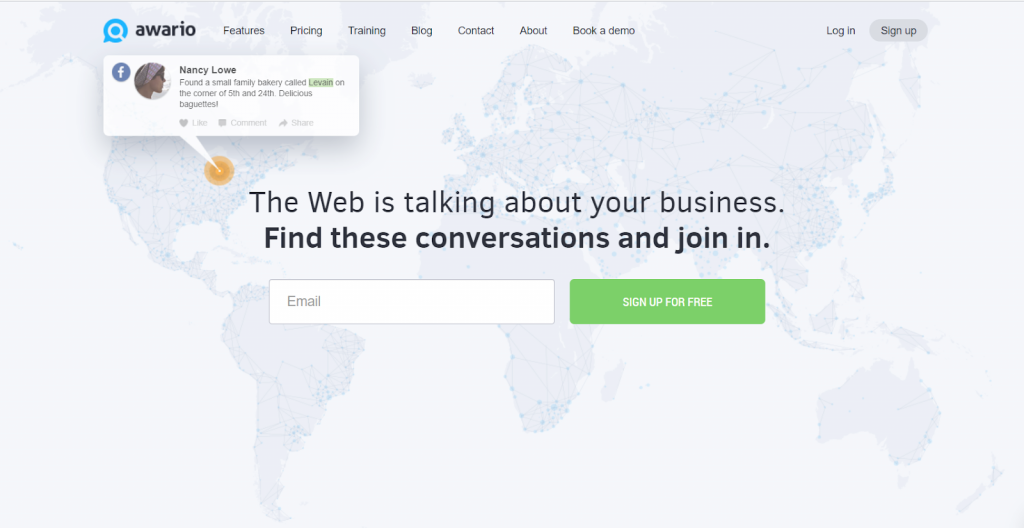
It also offers a social media customer support service that lets you be there right when your customers need your help.
Providing you with an intelligent alert system, the tool lets you know as soon as an important conversation starts gaining traction.
This helps you prioritize customer support requests based on the impact they can have on your business.
Awario is great for monitoring brand mentions and keeping track of online conversations. And it makes it possible to track unlinked brand mentions all over the web.
However, users report a steep learning curve. Also, the price can escalate quickly.
Price: Not provided.
Final Thoughts (They're talking about you, are you listening?)
Your audience is talking all the time. They’re having conversations about things they need, challenges they’re facing day-to-day, as well their opinions on particular topics. They give each other advice, review your product, as well as your competitors’ products.
By tuning in to these conversations, you’ll be able to get invaluable insight into customer sentiment and issues they need to solve.
You’ll also be able to spot opportunities as they arise, and generate ideas about content, product improvements, customer support initiatives and so on.
Social listening tools like Keyhole help you streamline social media management and derive insights from data quickly. Keyhole includes campaign tracking, influencer marketing, social listening as well as social scheduling capabilities – all in a single platform.
Our customers report that Keyhole saves them 5 hours a week on gathering and reporting data, which translates into over $7,000 saved every year.
See for yourself – start your zero-obligation free trial today and see how Keyhole can help you make data-driven decisions and work smarter.
Keyhole helps marketers make data-driven decisions while streamlining their social media management efforts. On top of campaign tracking, influencer marketing, and social listening, you can also schedule and publish your social media posts, all in one platform.
Start your free trial today and work smarter, not harder.
